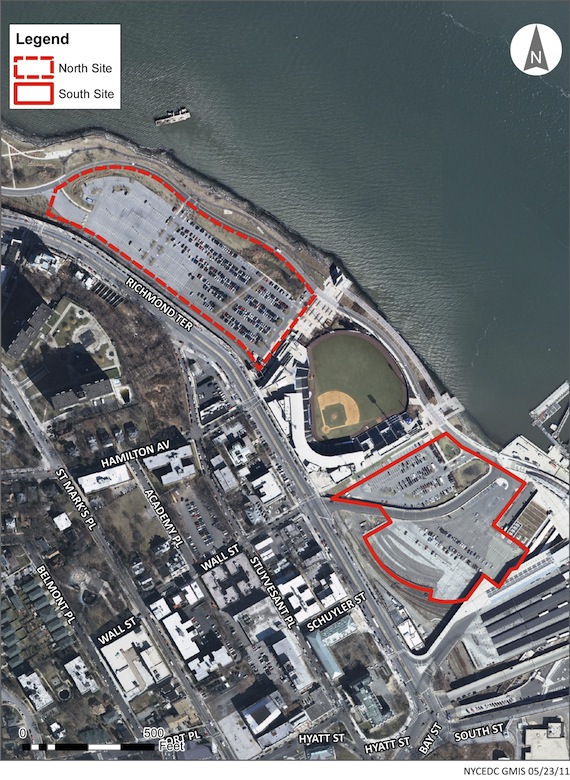
St. George Staten Island could become the region's next great downtown. That's the plan over at the New York City Economic Development Corporation, which is about to redevelop two waterfront sites immediately adjacent to the ferry terminal.
Yet even though EDC touts the unparalleled transit access at the sites, which are currently surface parking lots, and its desire to make this a pedestrian-friendly development, the agency is requiring that any development include a huge amount of parking. Not only would every surface space have to be replaced, but EDC intends to accommodate anyone who wants to drive to the developments and find a parking spot.
EDC makes the case for a vibrant urban development at St. George as well as anyone could in its request for expressions of interest, released yesterday:
The adjacent Ferry Terminal is Staten Island’s transit hub linking 70,000 daily commuters with the Staten Island Railroad, 20 Metropolitan Transportation Authority (“MTA”) bus lines, and the Bay Street and Richmond Terrace bikeway…
It is widely recognized that the neighborhood represents a great opportunity for Staten Island to accommodate significant population growth (Staten Island is expected to grow by +65,000 people in the next twenty years, including 35,000 seniors and 17,000 young adults) and establish the kind of vital downtown that has long eluded Staten Island but emerged in municipalities stretching from Jersey City to Long Branch.
Indeed, this is an ideal location for dense, downtown-style development. New Urbanist leader Jeff Speck even identified the site as crying out for construction in a presentation to the City Planning Commission in January of last year.
Yet EDC wants the island's transit center and would-be downtown to make room for a sea of parking, which will draw more traffic to the neighborhood streets, eat up space that could be used for housing or offices, and degrade the pedestrian environment. At this stage in the development process, it's not clear exactly how many spaces the new development might contain. But all the spaces in the enormous surface parking lots would have to replaced one for one, ensuring at least a full floor of parking almost by definition. On top of that, EDC expects that additional parking be provided for all "the expected demand produced by the proposed development." With 14 acres up for development, that could be quite a lot of spaces indeed.
In the past, EDC has used the formulas embedded in the environmental review process to predict demand for parking; those formulas have contributed to thousand-space lots at the New Domino development in Williamsburg and Riverside Center on Manhattan's West Side, among others.
That level of parking isn't necessary. Only 63 percent of Staten Islanders drive to work. If the borough were to secede from New York City, it would have fewer car commuters, as a percent, than Portland or Los Angeles, and just a hair more than Chicago. Moreover, St. George is on track to become even more transit-rich than it is today; the city is currently studying the creation of a bus or rail rapid transit line along Staten Island's north shore.
The prioritization of parking comes from the very top. In a press release announcing the development plans, the only official to mention parking was Mayor Michael Bloomberg himself. “The potential to develop these sites while maintaining the availability of parking – combined with projects at the Homeport, Howland Hook, and at the Ferry Terminal – will be a catalyst for the further revitalization of the North Shore, as well as the entire island.” EDC would not comment for this story beyond pointing us to the official press release.
The city's belief that a "vital downtown" is compatible with parking requirements flies in the face of experience. Downtown Manhattan was largely developed prior to the enactment of any parking regulations; today a strict parking maximum is in place. Downtown Brooklyn is largely zoned so that commercial development does not require off-street parking; developers and elected officials in the area have been pushing hard for the residential requirements to be eliminated as well.
Jersey City, ostensibly one of the city's models for St. George, took the opposite approach to parking in revitalizing its downtown. "Jersey City’s an interesting model for the area around the ferry terminal, since both places are transit-rich, with access to ferries, buses, and rail," explained Steven Higashide of the Tri-State Transportation Campaign. "In most downtown developments in Jersey City, developers aren’t required to provide any parking and there’s instead a parking maximum. That makes it less costly to build and makes it easier to create a lively streetscape that isn’t interrupted by parking lots and overrun with traffic."
EDC isn't the only guilty party in St. George. The St. George special zoning district, proposed by the Department of City Planning in 2008 and passed later that year, increased residential parking minimums to 100 percent and forbid developers from subdividing properties to waive the requirements. Keeping Staten Island suburban, even in its downtown, is official city policy.





